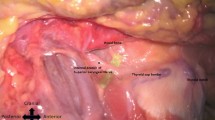Abstract
The functional results of a partial laryngeal surgery or a laryngeal reinnervation depend on the precise knowledge of the intra laryngeal anatomy of the inferior laryngeal nerve (ILN). Ten human larynges without known laryngeal disorders were obtained from human cadavers for ILN microdissection. Intra laryngeal ILN branching patterns were determined bilaterally. The lengths of the vertical, genu and oblique segments of the anterior division of ILN and the distance between the nerve within the paraglottic space and the cricothyroid articulation (CTA) were measured with a digital microcaliper. The mean lengths of the vertical, genu and oblique segments were 10.82, 5.89 and 9.29 mm, respectively. The mean distance between the nerve in the paraglottic space and the CTA was 11.20 mm. Key anatomical landmarks of the abductor division (vertical and genu segments of ILN) were the lateral border of posterior cricoarytenoid (PCA) muscle and the superior ligament of the CTA. The two-branch pattern for the lateral border of the PCA muscle has been the most frequent (50%). A branch of interarytenoid muscle (IA) originated from the genu segment. One or two branches for the PCA muscle has been identified in 75% of cases from the IA neural plexus on the front side of PCA muscle. The adductor division for the thyroarytenoid muscle and the lateral cricoarytenoid muscle was the oblique segment of the nerve. We conclude that abductor and adductor divisions of intra laryngeal ILN can be readily identified and the knowledge of key landmarks allows preservation of the ILN during partial surgery of the larynx and possibly selective muscle reinnervation.







Similar content being viewed by others
References
Damrose EJ, Huang RY, Ye M, Berke GS, Sercarz JA (2003) Surgical anatomy of the recurrent laryngeal nerve: implications for laryngeal reinnervation. Ann Otol Rhinol Laryngol 112:434–438
Hovelacque A (1927) Anatomie des nerfs crâniens et rachidiens et du système grand sympathique chez l’homme. Gaston Doin et Cie, Paris, pp 220–235
Laux R, Guerrier Y (1959) L’innervation des muscles du larynx. Bull l’Asso Anatom 105:46–52
Maranillo E, Leon X, Ibanez M, Orus C, Quer M, Sanudo JR (2003) Variability of the nerve supply patterns of the human posterior cricoarytenoid muscle. Laryngoscope 113:602–606
Maranillo E, Leon X, Orus C, Quer M, Sanudo JR (2005) Variability in nerve patterns of the adductor muscle group supplied by the recurrent laryngeal nerve. Laryngoscope 115:358–362
Nguyen M, Junien-Lavillauroy C, Faure C (1989) Anatomical intra-laryngeal anterior branch study of the recurrent (inferior) laryngeal nerve. Surg Radiol Anat 11:123–127
Prades JM, Dumollard JM, Timoshenko AP, Durand M, Martin C (2000) Descriptive anatomy of the cricoarytenoid articulation: applications to articular dynamics in carcinology. Surg Radiol Anat 22:277–282
Sanders I, Wu BL, Mu L, Li Y, Biller HF (1993) The innervation of the human larynx. Arch Otolaryngol Head Neck Surg 119:934–939
Sanders I, Jacobs I, Wu BL, Biller HF (1993) The three bellies of the canine posterior cricoarytenoid muscle: implications for understanding laryngeal functions. Laryngoscope 103:171–177
Sasaki CT, Hundal JS, Kim YH (2005) Protective glottic closure: biomechanical effects of selective laryngeal denervation. Ann Otol Rhinol Laryngol 114:271–275
Strome M, Stein J, Esclamado R, et al (2001) Laryngeal transplantation and 40–month follow-up. N Engl J Med 344:1676–1679
Tanaka S, Asato R, Hiratsuka Y (2004) Nerve-muscle transplantation to the paraglottic space after resection of recurrent laryngeal nerve. Laryngoscope 114:1118–1122
Toth A, Szucs A, Harasztosi C, Matesz K, Pucsok K, Miko I, Sziklai I (2005) Intrinsic laryngeal muscle reinnervation with nerve-muscle pedicle. Otolaryngol Head Neck Surg 132:701–706
Tucker HM, Rusnov M (1981) Laryngeal reinnervation for unilateral vocal cord paralysis: long term results. Ann Otol Rhinol Laryngol 90:457–459
Winckler G (1948) Remarques sur l’innervation motrice et sensitive des muscles du larynx. Compt Rend Ass Anat 55:424–428
Author information
Authors and Affiliations
Corresponding author
Rights and permissions
About this article
Cite this article
Prades, JM., Faye, M.B., Timoshenko, A.P. et al. Microsurgical anatomy of intralaryngeal distribution of the inferior laryngeal nerve. Surg Radiol Anat 28, 271–276 (2006). https://doi.org/10.1007/s00276-006-0083-2
Received:
Accepted:
Published:
Issue Date:
DOI: https://doi.org/10.1007/s00276-006-0083-2




